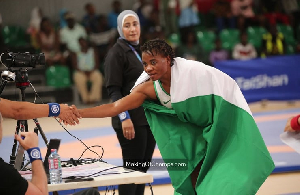The Federal Government is projecting nearly $1bn (about N1.49tn) in annual revenue from electricity exports to 15 West African Countries under the Economic Community of West African States sub-region from June 2026.
The earnings are based on what a full 600 megawatts export capacity is capable of generating at the prevailing regional tariff, as Nigeria pushes toward full participation in the West African power market following a landmark grid synchronisation exercise carried out this month.
The Minister of Power, Chief Adebayo Adelabu, hinted at the new revenue stream at a press conference on Wednesday in Abuja, where he announced that Nigeria successfully conducted a grid synchronisation test with 15 West African countries for four hours on November 8, 2025.
He said the development positions Nigeria to fully exploit its strategic role as the regional power hub under the West African Power Pool, especially as generation companies ramp up compliance with free-governor control, an operational discipline crucial to regional grid stability.
On November 8, 2025, Nigeria successfully conducted a grid synchronisation test connecting the national electricity grid with the interconnected West African Power Pool system.
The synchronisation exercise, conducted between 05:04 am and 09:04 am, involved the Nigerian grid, which includes the Niger Republic and parts of Benin and Togo, and the rest of West Africa’s interconnected systems covering Ghana, Côte d’Ivoire, Burkina Faso, Liberia, Sierra Leone, Guinea, Senegal, The Gambia, Guinea-Bissau, and Mali.
The minister said for four uninterrupted hours, power flowed seamlessly across national borders, operating at a single stable frequency and proving that West Africa is now technically capable of functioning as a unified power bloc. This exercise represents the first time in history that Nigeria has operated in a unified, stable, and fully harmonised configuration with the rest of the sub-region.
But beyond the latest achievement, the minister said the government is working toward achieving permanent grid synchronisation by June 2026, with a second 48-hour test run planned once ongoing discussions with regional operators are concluded.
The Executive Director, Market Operations at the Nigerian Independent System Operator, Edmund Eje, said Nigeria currently allocates 600MW for its bilateral power trade agreements each day. According to data from the Nigerian Electricity Regulatory Commission, Nigeria continues to offer the cheapest electricity tariffs in West Africa.
NERC figures show that the average approved end-user tariff in Nigeria is about $0.07 per kilowatt-hour (approximately N100.27/kWh), representing just 35.71 per cent of the average $0.19/kWh charged by several other countries in the sub-region.
If exported power is billed at this regional tariff, government officials estimate that delivering the full 600MW allocation could generate close to $1bn in annual revenue.
A breakdown of the figures shows that exporting 600MW, equivalent to 600,000 kilowatts, at the prevailing tariff of $0.19 per kilowatt-hour would fetch about $114,000 every hour. This translates to roughly $2.73m daily and an estimated $998.6m in annual revenue.
The projection assumes uninterrupted export of the contracted volume once a permanent grid synchronisation is completed at a tentative date of June 2026. Officials say the revenue could provide a critical buffer for the power sector, help reduce liquidity shortfalls, and accelerate expansion of regional energy markets.
The government, however, assured electricity consumers that exporting power to West African countries will not compromise supply to the domestic market. Speaking further in his address, Adelabu noted that the milestone also marks the most successful synchronisation attempt since 2007, when a trial collapsed after seven minutes.
He said, “The benefits of synchronisation with other WAPP countries would extend directly to the Nigerian people. A more stable grid improves the performance of essential services such as hospitals, water supply, transport systems, digital infrastructure, and public institutions.
“As ongoing transmission expansion projects, including the North-Core line, the Ajegunle 330 kV Substation, the Kaduna–Kano transmission upgrades, and the Gwagwalada–Gurara connection, are completed, synchronisation will help deliver more reliable power to homes and industries nationwide. While expectations must remain realistic, this achievement provides the structural foundation for the improvements Nigerians have long awaited.”
The minister added that Nigeria’s transmission wheeling capacity has risen to 8,500 megawatts, creating a more stable backbone for future export commitments. However, despite this available capacity, low demand from the electricity distribution companies has kept actual generation at around 5,000MW, leaving about 3,500MW stranded within the Nigerian Electricity Supply Industry. The industry achieved an all-time generation peak of 5,801.44MW earlier this year.
He said, “Today, the minimum grid capacity we can even communicate is 8,500MW of capacity. If our generation reaches 8,000MW today, the grid can comfortably and conveniently transmit it. We are even sure that it is higher than that, but it is put at a conservative level, at 8,500 MW.
“We have the capacity and the facility to generate more power in Nigeria, and investment is still open to interested power sector investors. As long as there is demand in the other 14 countries of West Africa, Nigeria can easily export energy to those countries.”
Earlier, at the NISO Maiden Stakeholders’ Engagement themed “Building a Resilient and Competitive Electricity Market – The Role of NISO,” Managing Director Abdul Mohammed said the successful grid synchronisation represents more than a technical achievement.
NISO Executive Director for Systems Operation, Nafisatu Ali, said that 60 per cent of Nigeria’s power-generating plants have now adopted the operating regime of free governor control, significantly boosting the country’s readiness for cross-border electricity trade.
She explained that since the Nigerian Electricity Regulatory Commission issued the directive on governor control, compliance has steadily improved. “Before now, compliance was very low, about 20 per cent. But as of the last check two days ago, at least 60 per cent of generators have implemented the three-governor system,” Ali said.
She noted that this advancement was evident during the recent grid synchronisation test, when a generator tripped in Côte d’Ivoire, and Nigerian generators responded automatically, maintaining stability.
“The intention is to achieve 100 per cent compliance. This system has already improved grid resilience, ensuring automatic responses whenever there is a tripping event,” she added.
The Free governor control is a critical operational regime in power systems that allows generating units to automatically respond to changes in grid frequency. When a generator trips or demand suddenly spikes, FGC enables other units to adjust output instantly, stabilising the grid without manual intervention.
With the system in place, Nigerian Gencos can respond automatically to frequency disturbances, reducing grid instability and strengthening investor confidence in the country’s electricity market.
Business News of Thursday, 20 November 2025
Source: www.punchng.com













